Report on Lead and Carbon Monoxide Exposure: Hygiene and Toxicology
VerifiedAdded on 2023/05/31
|10
|3420
|169
Report
AI Summary
This report provides an in-depth analysis of the hygiene and toxicology aspects of lead and carbon monoxide exposure. It details the sources of exposure, applicable occupational exposure limits, toxicokinetics (absorption, distribution, metabolism, and excretion), and toxicodynamics of both substances. Specifically, it addresses how exposure to lead can occur through lead-based paints and smelting processes, while carbon monoxide exposure is linked to incomplete combustion in faulty equipment. The report also discusses the permissible exposure limits in Singapore and the physiological mechanisms involved in the absorption and elimination of these toxins, highlighting the importance of understanding these processes for effective prevention and mitigation strategies. Desklib provides access to similar solved assignments and study tools for students.
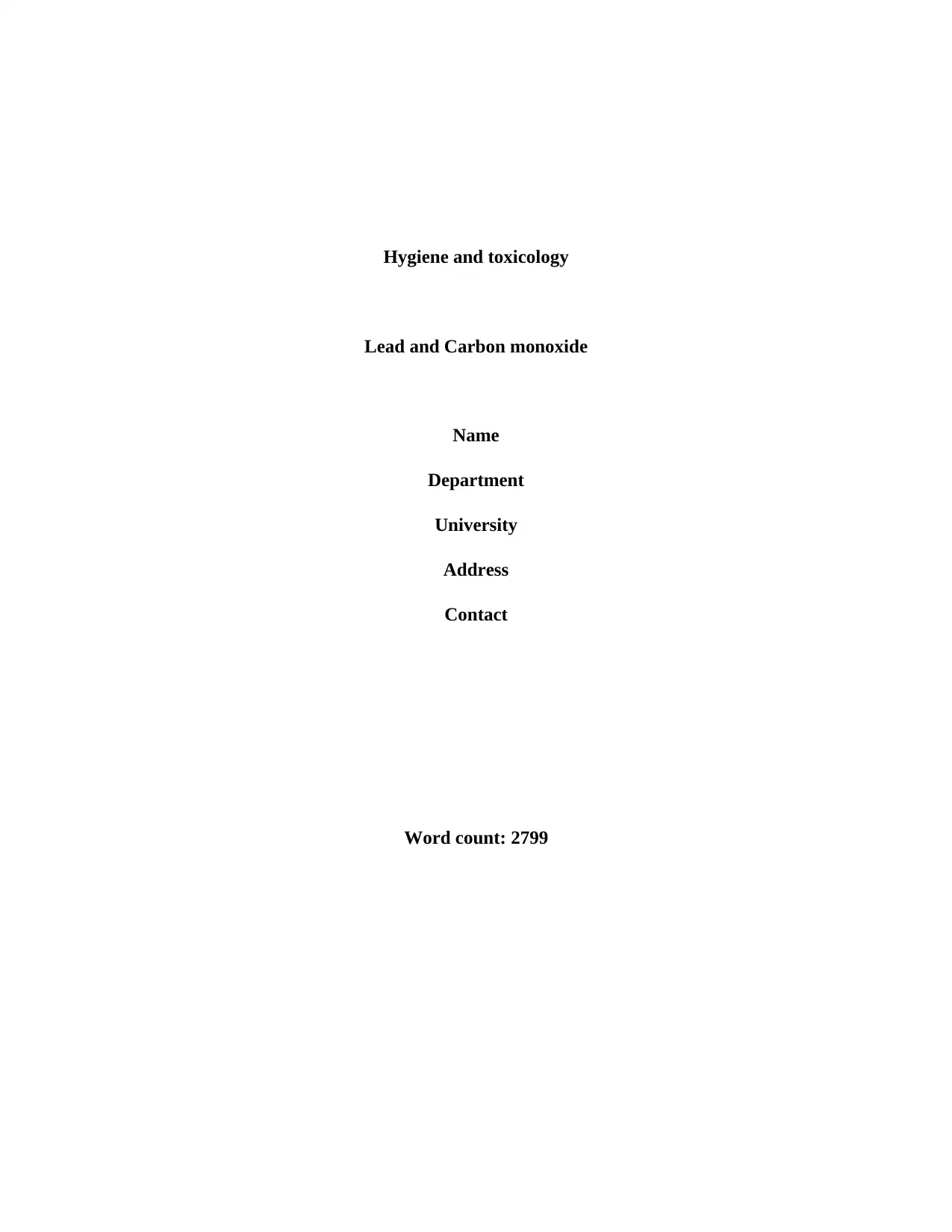
Hygiene and toxicology
Lead and Carbon monoxide
Name
Department
University
Address
Contact
Word count: 2799
Lead and Carbon monoxide
Name
Department
University
Address
Contact
Word count: 2799
Paraphrase This Document
Need a fresh take? Get an instant paraphrase of this document with our AI Paraphraser
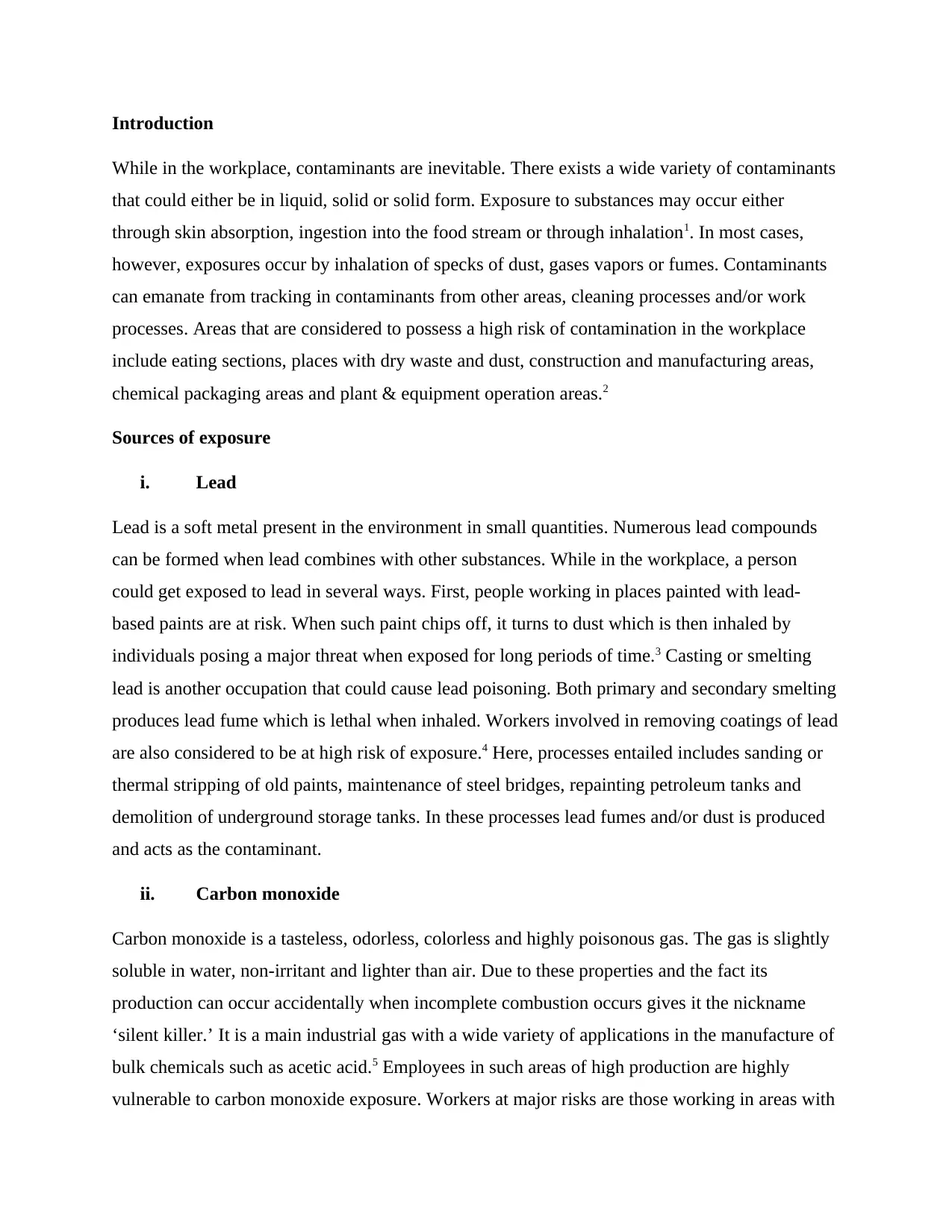
Introduction
While in the workplace, contaminants are inevitable. There exists a wide variety of contaminants
that could either be in liquid, solid or solid form. Exposure to substances may occur either
through skin absorption, ingestion into the food stream or through inhalation1. In most cases,
however, exposures occur by inhalation of specks of dust, gases vapors or fumes. Contaminants
can emanate from tracking in contaminants from other areas, cleaning processes and/or work
processes. Areas that are considered to possess a high risk of contamination in the workplace
include eating sections, places with dry waste and dust, construction and manufacturing areas,
chemical packaging areas and plant & equipment operation areas.2
Sources of exposure
i. Lead
Lead is a soft metal present in the environment in small quantities. Numerous lead compounds
can be formed when lead combines with other substances. While in the workplace, a person
could get exposed to lead in several ways. First, people working in places painted with lead-
based paints are at risk. When such paint chips off, it turns to dust which is then inhaled by
individuals posing a major threat when exposed for long periods of time.3 Casting or smelting
lead is another occupation that could cause lead poisoning. Both primary and secondary smelting
produces lead fume which is lethal when inhaled. Workers involved in removing coatings of lead
are also considered to be at high risk of exposure.4 Here, processes entailed includes sanding or
thermal stripping of old paints, maintenance of steel bridges, repainting petroleum tanks and
demolition of underground storage tanks. In these processes lead fumes and/or dust is produced
and acts as the contaminant.
ii. Carbon monoxide
Carbon monoxide is a tasteless, odorless, colorless and highly poisonous gas. The gas is slightly
soluble in water, non-irritant and lighter than air. Due to these properties and the fact its
production can occur accidentally when incomplete combustion occurs gives it the nickname
‘silent killer.’ It is a main industrial gas with a wide variety of applications in the manufacture of
bulk chemicals such as acetic acid.5 Employees in such areas of high production are highly
vulnerable to carbon monoxide exposure. Workers at major risks are those working in areas with
While in the workplace, contaminants are inevitable. There exists a wide variety of contaminants
that could either be in liquid, solid or solid form. Exposure to substances may occur either
through skin absorption, ingestion into the food stream or through inhalation1. In most cases,
however, exposures occur by inhalation of specks of dust, gases vapors or fumes. Contaminants
can emanate from tracking in contaminants from other areas, cleaning processes and/or work
processes. Areas that are considered to possess a high risk of contamination in the workplace
include eating sections, places with dry waste and dust, construction and manufacturing areas,
chemical packaging areas and plant & equipment operation areas.2
Sources of exposure
i. Lead
Lead is a soft metal present in the environment in small quantities. Numerous lead compounds
can be formed when lead combines with other substances. While in the workplace, a person
could get exposed to lead in several ways. First, people working in places painted with lead-
based paints are at risk. When such paint chips off, it turns to dust which is then inhaled by
individuals posing a major threat when exposed for long periods of time.3 Casting or smelting
lead is another occupation that could cause lead poisoning. Both primary and secondary smelting
produces lead fume which is lethal when inhaled. Workers involved in removing coatings of lead
are also considered to be at high risk of exposure.4 Here, processes entailed includes sanding or
thermal stripping of old paints, maintenance of steel bridges, repainting petroleum tanks and
demolition of underground storage tanks. In these processes lead fumes and/or dust is produced
and acts as the contaminant.
ii. Carbon monoxide
Carbon monoxide is a tasteless, odorless, colorless and highly poisonous gas. The gas is slightly
soluble in water, non-irritant and lighter than air. Due to these properties and the fact its
production can occur accidentally when incomplete combustion occurs gives it the nickname
‘silent killer.’ It is a main industrial gas with a wide variety of applications in the manufacture of
bulk chemicals such as acetic acid.5 Employees in such areas of high production are highly
vulnerable to carbon monoxide exposure. Workers at major risks are those working in areas with
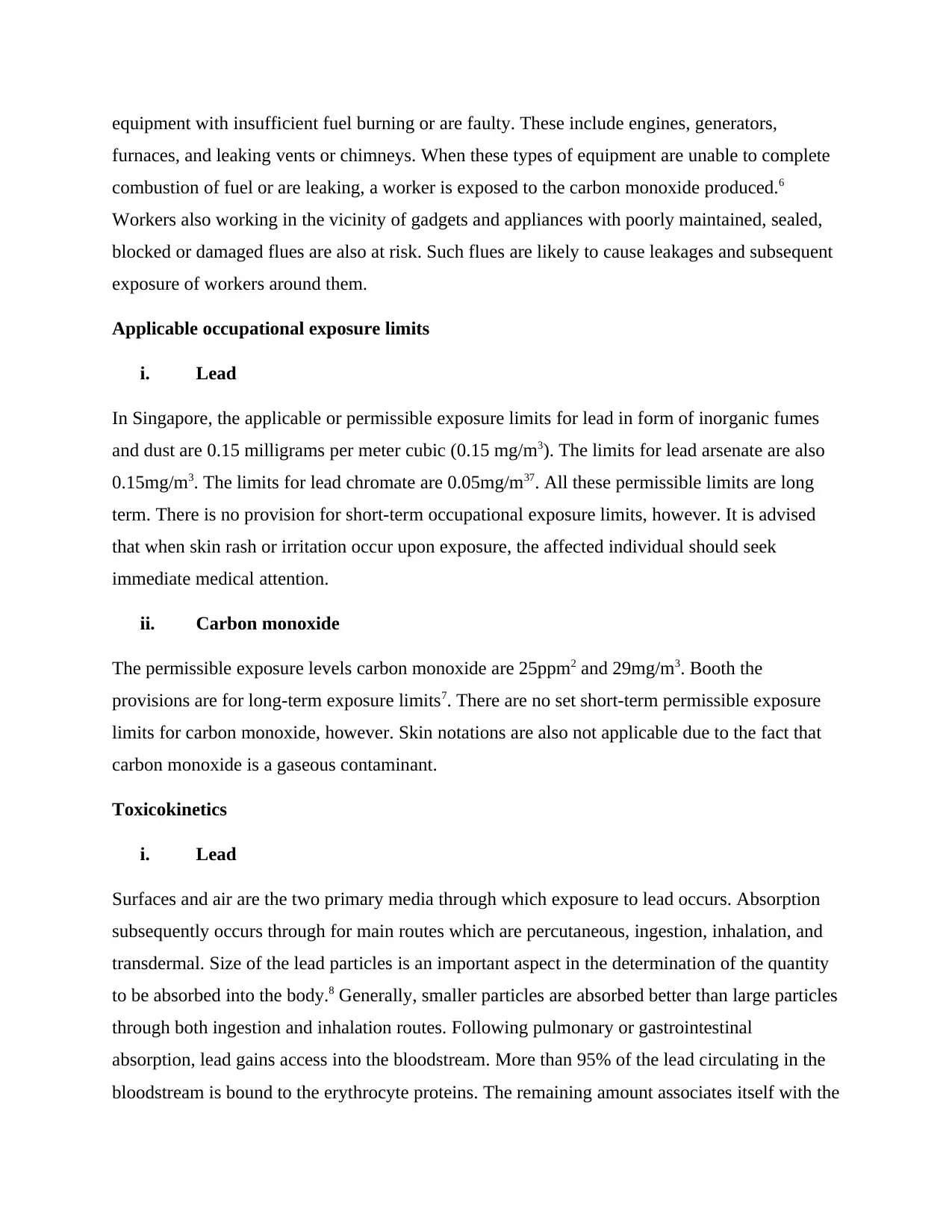
equipment with insufficient fuel burning or are faulty. These include engines, generators,
furnaces, and leaking vents or chimneys. When these types of equipment are unable to complete
combustion of fuel or are leaking, a worker is exposed to the carbon monoxide produced.6
Workers also working in the vicinity of gadgets and appliances with poorly maintained, sealed,
blocked or damaged flues are also at risk. Such flues are likely to cause leakages and subsequent
exposure of workers around them.
Applicable occupational exposure limits
i. Lead
In Singapore, the applicable or permissible exposure limits for lead in form of inorganic fumes
and dust are 0.15 milligrams per meter cubic (0.15 mg/m3). The limits for lead arsenate are also
0.15mg/m3. The limits for lead chromate are 0.05mg/m37. All these permissible limits are long
term. There is no provision for short-term occupational exposure limits, however. It is advised
that when skin rash or irritation occur upon exposure, the affected individual should seek
immediate medical attention.
ii. Carbon monoxide
The permissible exposure levels carbon monoxide are 25ppm2 and 29mg/m3. Booth the
provisions are for long-term exposure limits7. There are no set short-term permissible exposure
limits for carbon monoxide, however. Skin notations are also not applicable due to the fact that
carbon monoxide is a gaseous contaminant.
Toxicokinetics
i. Lead
Surfaces and air are the two primary media through which exposure to lead occurs. Absorption
subsequently occurs through for main routes which are percutaneous, ingestion, inhalation, and
transdermal. Size of the lead particles is an important aspect in the determination of the quantity
to be absorbed into the body.8 Generally, smaller particles are absorbed better than large particles
through both ingestion and inhalation routes. Following pulmonary or gastrointestinal
absorption, lead gains access into the bloodstream. More than 95% of the lead circulating in the
bloodstream is bound to the erythrocyte proteins. The remaining amount associates itself with the
furnaces, and leaking vents or chimneys. When these types of equipment are unable to complete
combustion of fuel or are leaking, a worker is exposed to the carbon monoxide produced.6
Workers also working in the vicinity of gadgets and appliances with poorly maintained, sealed,
blocked or damaged flues are also at risk. Such flues are likely to cause leakages and subsequent
exposure of workers around them.
Applicable occupational exposure limits
i. Lead
In Singapore, the applicable or permissible exposure limits for lead in form of inorganic fumes
and dust are 0.15 milligrams per meter cubic (0.15 mg/m3). The limits for lead arsenate are also
0.15mg/m3. The limits for lead chromate are 0.05mg/m37. All these permissible limits are long
term. There is no provision for short-term occupational exposure limits, however. It is advised
that when skin rash or irritation occur upon exposure, the affected individual should seek
immediate medical attention.
ii. Carbon monoxide
The permissible exposure levels carbon monoxide are 25ppm2 and 29mg/m3. Booth the
provisions are for long-term exposure limits7. There are no set short-term permissible exposure
limits for carbon monoxide, however. Skin notations are also not applicable due to the fact that
carbon monoxide is a gaseous contaminant.
Toxicokinetics
i. Lead
Surfaces and air are the two primary media through which exposure to lead occurs. Absorption
subsequently occurs through for main routes which are percutaneous, ingestion, inhalation, and
transdermal. Size of the lead particles is an important aspect in the determination of the quantity
to be absorbed into the body.8 Generally, smaller particles are absorbed better than large particles
through both ingestion and inhalation routes. Following pulmonary or gastrointestinal
absorption, lead gains access into the bloodstream. More than 95% of the lead circulating in the
bloodstream is bound to the erythrocyte proteins. The remaining amount associates itself with the
⊘ This is a preview!⊘
Do you want full access?
Subscribe today to unlock all pages.

Trusted by 1+ million students worldwide
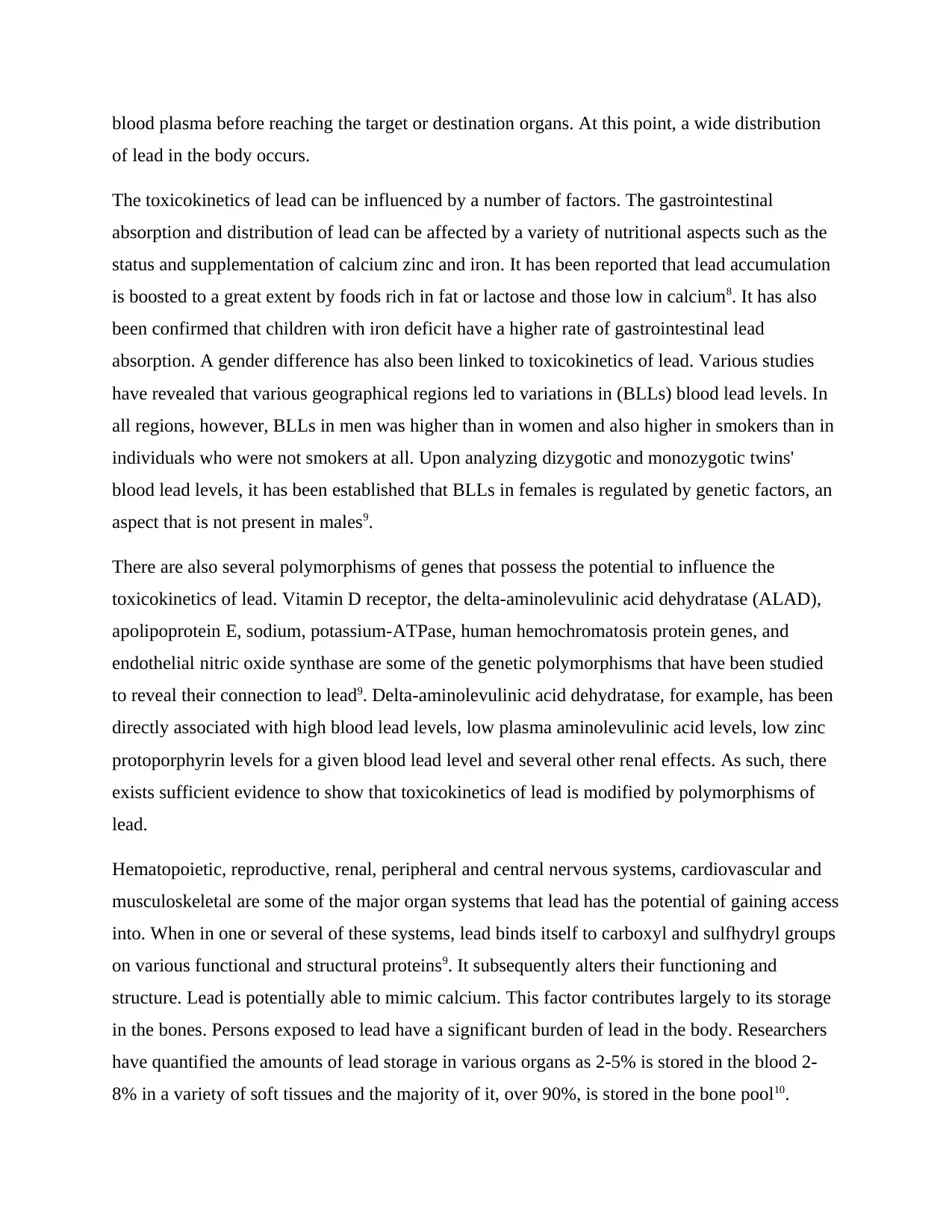
blood plasma before reaching the target or destination organs. At this point, a wide distribution
of lead in the body occurs.
The toxicokinetics of lead can be influenced by a number of factors. The gastrointestinal
absorption and distribution of lead can be affected by a variety of nutritional aspects such as the
status and supplementation of calcium zinc and iron. It has been reported that lead accumulation
is boosted to a great extent by foods rich in fat or lactose and those low in calcium8. It has also
been confirmed that children with iron deficit have a higher rate of gastrointestinal lead
absorption. A gender difference has also been linked to toxicokinetics of lead. Various studies
have revealed that various geographical regions led to variations in (BLLs) blood lead levels. In
all regions, however, BLLs in men was higher than in women and also higher in smokers than in
individuals who were not smokers at all. Upon analyzing dizygotic and monozygotic twins'
blood lead levels, it has been established that BLLs in females is regulated by genetic factors, an
aspect that is not present in males9.
There are also several polymorphisms of genes that possess the potential to influence the
toxicokinetics of lead. Vitamin D receptor, the delta-aminolevulinic acid dehydratase (ALAD),
apolipoprotein E, sodium, potassium-ATPase, human hemochromatosis protein genes, and
endothelial nitric oxide synthase are some of the genetic polymorphisms that have been studied
to reveal their connection to lead9. Delta-aminolevulinic acid dehydratase, for example, has been
directly associated with high blood lead levels, low plasma aminolevulinic acid levels, low zinc
protoporphyrin levels for a given blood lead level and several other renal effects. As such, there
exists sufficient evidence to show that toxicokinetics of lead is modified by polymorphisms of
lead.
Hematopoietic, reproductive, renal, peripheral and central nervous systems, cardiovascular and
musculoskeletal are some of the major organ systems that lead has the potential of gaining access
into. When in one or several of these systems, lead binds itself to carboxyl and sulfhydryl groups
on various functional and structural proteins9. It subsequently alters their functioning and
structure. Lead is potentially able to mimic calcium. This factor contributes largely to its storage
in the bones. Persons exposed to lead have a significant burden of lead in the body. Researchers
have quantified the amounts of lead storage in various organs as 2-5% is stored in the blood 2-
8% in a variety of soft tissues and the majority of it, over 90%, is stored in the bone pool10.
of lead in the body occurs.
The toxicokinetics of lead can be influenced by a number of factors. The gastrointestinal
absorption and distribution of lead can be affected by a variety of nutritional aspects such as the
status and supplementation of calcium zinc and iron. It has been reported that lead accumulation
is boosted to a great extent by foods rich in fat or lactose and those low in calcium8. It has also
been confirmed that children with iron deficit have a higher rate of gastrointestinal lead
absorption. A gender difference has also been linked to toxicokinetics of lead. Various studies
have revealed that various geographical regions led to variations in (BLLs) blood lead levels. In
all regions, however, BLLs in men was higher than in women and also higher in smokers than in
individuals who were not smokers at all. Upon analyzing dizygotic and monozygotic twins'
blood lead levels, it has been established that BLLs in females is regulated by genetic factors, an
aspect that is not present in males9.
There are also several polymorphisms of genes that possess the potential to influence the
toxicokinetics of lead. Vitamin D receptor, the delta-aminolevulinic acid dehydratase (ALAD),
apolipoprotein E, sodium, potassium-ATPase, human hemochromatosis protein genes, and
endothelial nitric oxide synthase are some of the genetic polymorphisms that have been studied
to reveal their connection to lead9. Delta-aminolevulinic acid dehydratase, for example, has been
directly associated with high blood lead levels, low plasma aminolevulinic acid levels, low zinc
protoporphyrin levels for a given blood lead level and several other renal effects. As such, there
exists sufficient evidence to show that toxicokinetics of lead is modified by polymorphisms of
lead.
Hematopoietic, reproductive, renal, peripheral and central nervous systems, cardiovascular and
musculoskeletal are some of the major organ systems that lead has the potential of gaining access
into. When in one or several of these systems, lead binds itself to carboxyl and sulfhydryl groups
on various functional and structural proteins9. It subsequently alters their functioning and
structure. Lead is potentially able to mimic calcium. This factor contributes largely to its storage
in the bones. Persons exposed to lead have a significant burden of lead in the body. Researchers
have quantified the amounts of lead storage in various organs as 2-5% is stored in the blood 2-
8% in a variety of soft tissues and the majority of it, over 90%, is stored in the bone pool10.
Paraphrase This Document
Need a fresh take? Get an instant paraphrase of this document with our AI Paraphraser
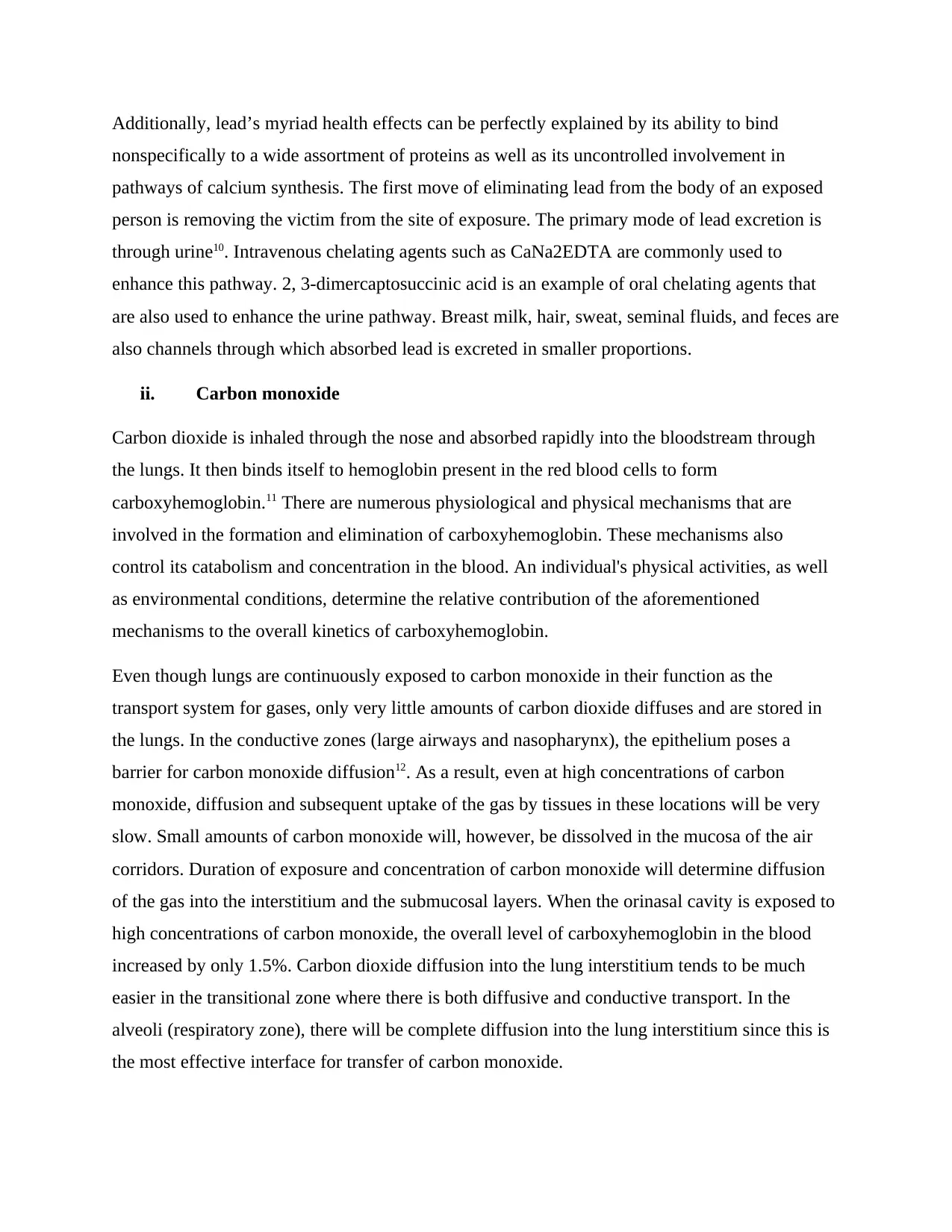
Additionally, lead’s myriad health effects can be perfectly explained by its ability to bind
nonspecifically to a wide assortment of proteins as well as its uncontrolled involvement in
pathways of calcium synthesis. The first move of eliminating lead from the body of an exposed
person is removing the victim from the site of exposure. The primary mode of lead excretion is
through urine10. Intravenous chelating agents such as CaNa2EDTA are commonly used to
enhance this pathway. 2, 3-dimercaptosuccinic acid is an example of oral chelating agents that
are also used to enhance the urine pathway. Breast milk, hair, sweat, seminal fluids, and feces are
also channels through which absorbed lead is excreted in smaller proportions.
ii. Carbon monoxide
Carbon dioxide is inhaled through the nose and absorbed rapidly into the bloodstream through
the lungs. It then binds itself to hemoglobin present in the red blood cells to form
carboxyhemoglobin.11 There are numerous physiological and physical mechanisms that are
involved in the formation and elimination of carboxyhemoglobin. These mechanisms also
control its catabolism and concentration in the blood. An individual's physical activities, as well
as environmental conditions, determine the relative contribution of the aforementioned
mechanisms to the overall kinetics of carboxyhemoglobin.
Even though lungs are continuously exposed to carbon monoxide in their function as the
transport system for gases, only very little amounts of carbon dioxide diffuses and are stored in
the lungs. In the conductive zones (large airways and nasopharynx), the epithelium poses a
barrier for carbon monoxide diffusion12. As a result, even at high concentrations of carbon
monoxide, diffusion and subsequent uptake of the gas by tissues in these locations will be very
slow. Small amounts of carbon monoxide will, however, be dissolved in the mucosa of the air
corridors. Duration of exposure and concentration of carbon monoxide will determine diffusion
of the gas into the interstitium and the submucosal layers. When the orinasal cavity is exposed to
high concentrations of carbon monoxide, the overall level of carboxyhemoglobin in the blood
increased by only 1.5%. Carbon dioxide diffusion into the lung interstitium tends to be much
easier in the transitional zone where there is both diffusive and conductive transport. In the
alveoli (respiratory zone), there will be complete diffusion into the lung interstitium since this is
the most effective interface for transfer of carbon monoxide.
nonspecifically to a wide assortment of proteins as well as its uncontrolled involvement in
pathways of calcium synthesis. The first move of eliminating lead from the body of an exposed
person is removing the victim from the site of exposure. The primary mode of lead excretion is
through urine10. Intravenous chelating agents such as CaNa2EDTA are commonly used to
enhance this pathway. 2, 3-dimercaptosuccinic acid is an example of oral chelating agents that
are also used to enhance the urine pathway. Breast milk, hair, sweat, seminal fluids, and feces are
also channels through which absorbed lead is excreted in smaller proportions.
ii. Carbon monoxide
Carbon dioxide is inhaled through the nose and absorbed rapidly into the bloodstream through
the lungs. It then binds itself to hemoglobin present in the red blood cells to form
carboxyhemoglobin.11 There are numerous physiological and physical mechanisms that are
involved in the formation and elimination of carboxyhemoglobin. These mechanisms also
control its catabolism and concentration in the blood. An individual's physical activities, as well
as environmental conditions, determine the relative contribution of the aforementioned
mechanisms to the overall kinetics of carboxyhemoglobin.
Even though lungs are continuously exposed to carbon monoxide in their function as the
transport system for gases, only very little amounts of carbon dioxide diffuses and are stored in
the lungs. In the conductive zones (large airways and nasopharynx), the epithelium poses a
barrier for carbon monoxide diffusion12. As a result, even at high concentrations of carbon
monoxide, diffusion and subsequent uptake of the gas by tissues in these locations will be very
slow. Small amounts of carbon monoxide will, however, be dissolved in the mucosa of the air
corridors. Duration of exposure and concentration of carbon monoxide will determine diffusion
of the gas into the interstitium and the submucosal layers. When the orinasal cavity is exposed to
high concentrations of carbon monoxide, the overall level of carboxyhemoglobin in the blood
increased by only 1.5%. Carbon dioxide diffusion into the lung interstitium tends to be much
easier in the transitional zone where there is both diffusive and conductive transport. In the
alveoli (respiratory zone), there will be complete diffusion into the lung interstitium since this is
the most effective interface for transfer of carbon monoxide.
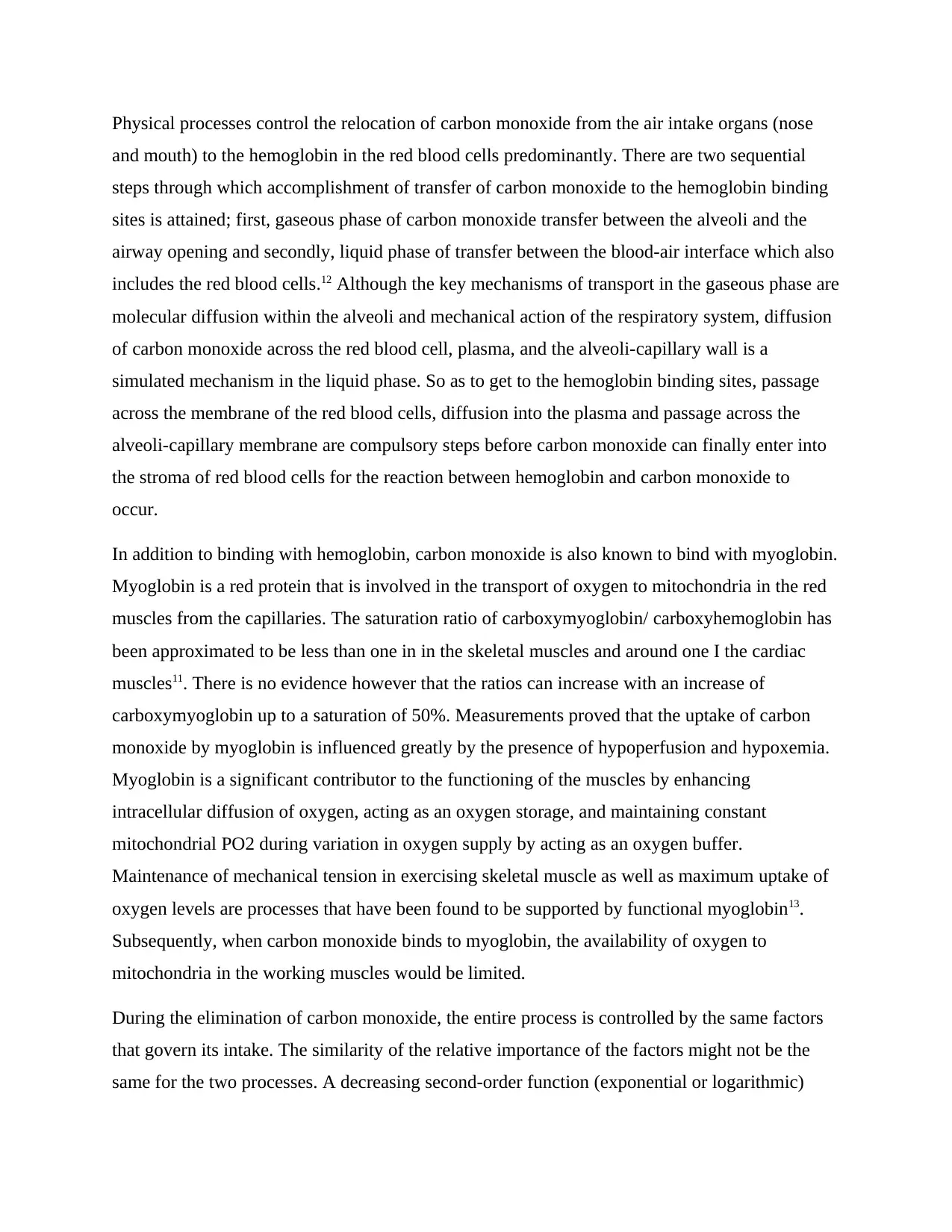
Physical processes control the relocation of carbon monoxide from the air intake organs (nose
and mouth) to the hemoglobin in the red blood cells predominantly. There are two sequential
steps through which accomplishment of transfer of carbon monoxide to the hemoglobin binding
sites is attained; first, gaseous phase of carbon monoxide transfer between the alveoli and the
airway opening and secondly, liquid phase of transfer between the blood-air interface which also
includes the red blood cells.12 Although the key mechanisms of transport in the gaseous phase are
molecular diffusion within the alveoli and mechanical action of the respiratory system, diffusion
of carbon monoxide across the red blood cell, plasma, and the alveoli-capillary wall is a
simulated mechanism in the liquid phase. So as to get to the hemoglobin binding sites, passage
across the membrane of the red blood cells, diffusion into the plasma and passage across the
alveoli-capillary membrane are compulsory steps before carbon monoxide can finally enter into
the stroma of red blood cells for the reaction between hemoglobin and carbon monoxide to
occur.
In addition to binding with hemoglobin, carbon monoxide is also known to bind with myoglobin.
Myoglobin is a red protein that is involved in the transport of oxygen to mitochondria in the red
muscles from the capillaries. The saturation ratio of carboxymyoglobin/ carboxyhemoglobin has
been approximated to be less than one in in the skeletal muscles and around one I the cardiac
muscles11. There is no evidence however that the ratios can increase with an increase of
carboxymyoglobin up to a saturation of 50%. Measurements proved that the uptake of carbon
monoxide by myoglobin is influenced greatly by the presence of hypoperfusion and hypoxemia.
Myoglobin is a significant contributor to the functioning of the muscles by enhancing
intracellular diffusion of oxygen, acting as an oxygen storage, and maintaining constant
mitochondrial PO2 during variation in oxygen supply by acting as an oxygen buffer.
Maintenance of mechanical tension in exercising skeletal muscle as well as maximum uptake of
oxygen levels are processes that have been found to be supported by functional myoglobin13.
Subsequently, when carbon monoxide binds to myoglobin, the availability of oxygen to
mitochondria in the working muscles would be limited.
During the elimination of carbon monoxide, the entire process is controlled by the same factors
that govern its intake. The similarity of the relative importance of the factors might not be the
same for the two processes. A decreasing second-order function (exponential or logarithmic)
and mouth) to the hemoglobin in the red blood cells predominantly. There are two sequential
steps through which accomplishment of transfer of carbon monoxide to the hemoglobin binding
sites is attained; first, gaseous phase of carbon monoxide transfer between the alveoli and the
airway opening and secondly, liquid phase of transfer between the blood-air interface which also
includes the red blood cells.12 Although the key mechanisms of transport in the gaseous phase are
molecular diffusion within the alveoli and mechanical action of the respiratory system, diffusion
of carbon monoxide across the red blood cell, plasma, and the alveoli-capillary wall is a
simulated mechanism in the liquid phase. So as to get to the hemoglobin binding sites, passage
across the membrane of the red blood cells, diffusion into the plasma and passage across the
alveoli-capillary membrane are compulsory steps before carbon monoxide can finally enter into
the stroma of red blood cells for the reaction between hemoglobin and carbon monoxide to
occur.
In addition to binding with hemoglobin, carbon monoxide is also known to bind with myoglobin.
Myoglobin is a red protein that is involved in the transport of oxygen to mitochondria in the red
muscles from the capillaries. The saturation ratio of carboxymyoglobin/ carboxyhemoglobin has
been approximated to be less than one in in the skeletal muscles and around one I the cardiac
muscles11. There is no evidence however that the ratios can increase with an increase of
carboxymyoglobin up to a saturation of 50%. Measurements proved that the uptake of carbon
monoxide by myoglobin is influenced greatly by the presence of hypoperfusion and hypoxemia.
Myoglobin is a significant contributor to the functioning of the muscles by enhancing
intracellular diffusion of oxygen, acting as an oxygen storage, and maintaining constant
mitochondrial PO2 during variation in oxygen supply by acting as an oxygen buffer.
Maintenance of mechanical tension in exercising skeletal muscle as well as maximum uptake of
oxygen levels are processes that have been found to be supported by functional myoglobin13.
Subsequently, when carbon monoxide binds to myoglobin, the availability of oxygen to
mitochondria in the working muscles would be limited.
During the elimination of carbon monoxide, the entire process is controlled by the same factors
that govern its intake. The similarity of the relative importance of the factors might not be the
same for the two processes. A decreasing second-order function (exponential or logarithmic)
⊘ This is a preview!⊘
Do you want full access?
Subscribe today to unlock all pages.

Trusted by 1+ million students worldwide
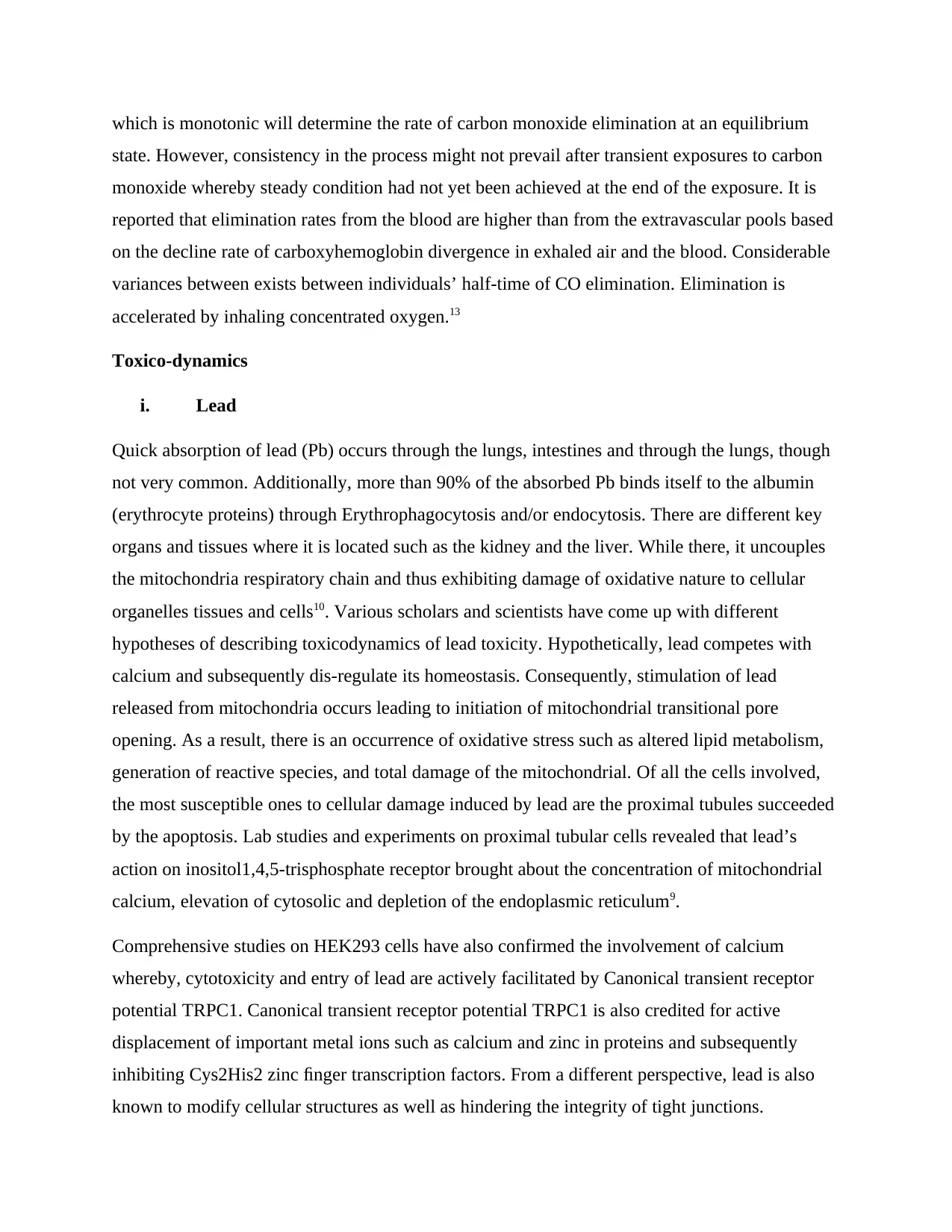
which is monotonic will determine the rate of carbon monoxide elimination at an equilibrium
state. However, consistency in the process might not prevail after transient exposures to carbon
monoxide whereby steady condition had not yet been achieved at the end of the exposure. It is
reported that elimination rates from the blood are higher than from the extravascular pools based
on the decline rate of carboxyhemoglobin divergence in exhaled air and the blood. Considerable
variances between exists between individuals’ half-time of CO elimination. Elimination is
accelerated by inhaling concentrated oxygen.13
Toxico-dynamics
i. Lead
Quick absorption of lead (Pb) occurs through the lungs, intestines and through the lungs, though
not very common. Additionally, more than 90% of the absorbed Pb binds itself to the albumin
(erythrocyte proteins) through Erythrophagocytosis and/or endocytosis. There are different key
organs and tissues where it is located such as the kidney and the liver. While there, it uncouples
the mitochondria respiratory chain and thus exhibiting damage of oxidative nature to cellular
organelles tissues and cells10. Various scholars and scientists have come up with different
hypotheses of describing toxicodynamics of lead toxicity. Hypothetically, lead competes with
calcium and subsequently dis-regulate its homeostasis. Consequently, stimulation of lead
released from mitochondria occurs leading to initiation of mitochondrial transitional pore
opening. As a result, there is an occurrence of oxidative stress such as altered lipid metabolism,
generation of reactive species, and total damage of the mitochondrial. Of all the cells involved,
the most susceptible ones to cellular damage induced by lead are the proximal tubules succeeded
by the apoptosis. Lab studies and experiments on proximal tubular cells revealed that lead’s
action on inositol1,4,5-trisphosphate receptor brought about the concentration of mitochondrial
calcium, elevation of cytosolic and depletion of the endoplasmic reticulum9.
Comprehensive studies on HEK293 cells have also confirmed the involvement of calcium
whereby, cytotoxicity and entry of lead are actively facilitated by Canonical transient receptor
potential TRPC1. Canonical transient receptor potential TRPC1 is also credited for active
displacement of important metal ions such as calcium and zinc in proteins and subsequently
inhibiting Cys2His2 zinc finger transcription factors. From a different perspective, lead is also
known to modify cellular structures as well as hindering the integrity of tight junctions.
state. However, consistency in the process might not prevail after transient exposures to carbon
monoxide whereby steady condition had not yet been achieved at the end of the exposure. It is
reported that elimination rates from the blood are higher than from the extravascular pools based
on the decline rate of carboxyhemoglobin divergence in exhaled air and the blood. Considerable
variances between exists between individuals’ half-time of CO elimination. Elimination is
accelerated by inhaling concentrated oxygen.13
Toxico-dynamics
i. Lead
Quick absorption of lead (Pb) occurs through the lungs, intestines and through the lungs, though
not very common. Additionally, more than 90% of the absorbed Pb binds itself to the albumin
(erythrocyte proteins) through Erythrophagocytosis and/or endocytosis. There are different key
organs and tissues where it is located such as the kidney and the liver. While there, it uncouples
the mitochondria respiratory chain and thus exhibiting damage of oxidative nature to cellular
organelles tissues and cells10. Various scholars and scientists have come up with different
hypotheses of describing toxicodynamics of lead toxicity. Hypothetically, lead competes with
calcium and subsequently dis-regulate its homeostasis. Consequently, stimulation of lead
released from mitochondria occurs leading to initiation of mitochondrial transitional pore
opening. As a result, there is an occurrence of oxidative stress such as altered lipid metabolism,
generation of reactive species, and total damage of the mitochondrial. Of all the cells involved,
the most susceptible ones to cellular damage induced by lead are the proximal tubules succeeded
by the apoptosis. Lab studies and experiments on proximal tubular cells revealed that lead’s
action on inositol1,4,5-trisphosphate receptor brought about the concentration of mitochondrial
calcium, elevation of cytosolic and depletion of the endoplasmic reticulum9.
Comprehensive studies on HEK293 cells have also confirmed the involvement of calcium
whereby, cytotoxicity and entry of lead are actively facilitated by Canonical transient receptor
potential TRPC1. Canonical transient receptor potential TRPC1 is also credited for active
displacement of important metal ions such as calcium and zinc in proteins and subsequently
inhibiting Cys2His2 zinc finger transcription factors. From a different perspective, lead is also
known to modify cellular structures as well as hindering the integrity of tight junctions.
Paraphrase This Document
Need a fresh take? Get an instant paraphrase of this document with our AI Paraphraser
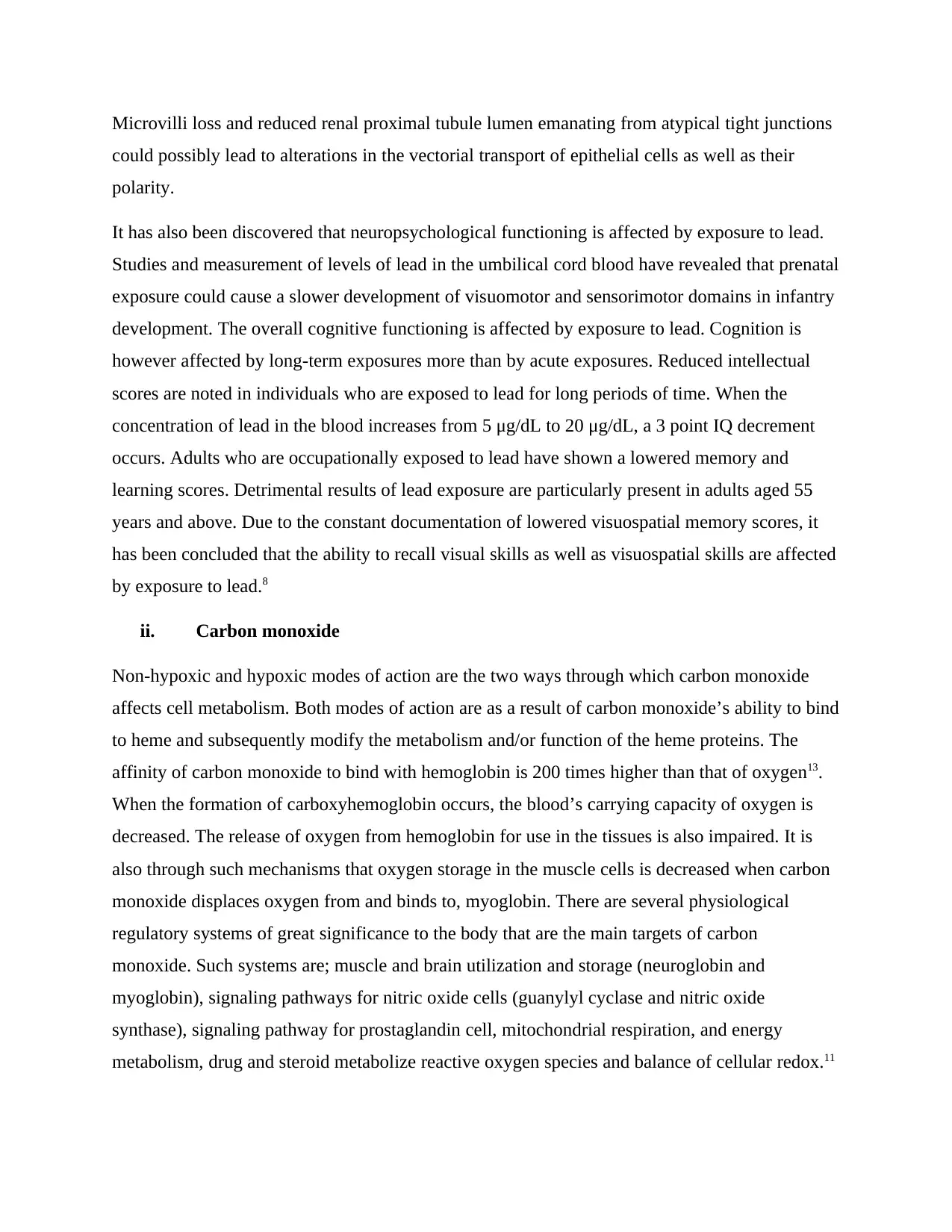
Microvilli loss and reduced renal proximal tubule lumen emanating from atypical tight junctions
could possibly lead to alterations in the vectorial transport of epithelial cells as well as their
polarity.
It has also been discovered that neuropsychological functioning is affected by exposure to lead.
Studies and measurement of levels of lead in the umbilical cord blood have revealed that prenatal
exposure could cause a slower development of visuomotor and sensorimotor domains in infantry
development. The overall cognitive functioning is affected by exposure to lead. Cognition is
however affected by long-term exposures more than by acute exposures. Reduced intellectual
scores are noted in individuals who are exposed to lead for long periods of time. When the
concentration of lead in the blood increases from 5 μg/dL to 20 μg/dL, a 3 point IQ decrement
occurs. Adults who are occupationally exposed to lead have shown a lowered memory and
learning scores. Detrimental results of lead exposure are particularly present in adults aged 55
years and above. Due to the constant documentation of lowered visuospatial memory scores, it
has been concluded that the ability to recall visual skills as well as visuospatial skills are affected
by exposure to lead.8
ii. Carbon monoxide
Non-hypoxic and hypoxic modes of action are the two ways through which carbon monoxide
affects cell metabolism. Both modes of action are as a result of carbon monoxide’s ability to bind
to heme and subsequently modify the metabolism and/or function of the heme proteins. The
affinity of carbon monoxide to bind with hemoglobin is 200 times higher than that of oxygen13.
When the formation of carboxyhemoglobin occurs, the blood’s carrying capacity of oxygen is
decreased. The release of oxygen from hemoglobin for use in the tissues is also impaired. It is
also through such mechanisms that oxygen storage in the muscle cells is decreased when carbon
monoxide displaces oxygen from and binds to, myoglobin. There are several physiological
regulatory systems of great significance to the body that are the main targets of carbon
monoxide. Such systems are; muscle and brain utilization and storage (neuroglobin and
myoglobin), signaling pathways for nitric oxide cells (guanylyl cyclase and nitric oxide
synthase), signaling pathway for prostaglandin cell, mitochondrial respiration, and energy
metabolism, drug and steroid metabolize reactive oxygen species and balance of cellular redox.11
could possibly lead to alterations in the vectorial transport of epithelial cells as well as their
polarity.
It has also been discovered that neuropsychological functioning is affected by exposure to lead.
Studies and measurement of levels of lead in the umbilical cord blood have revealed that prenatal
exposure could cause a slower development of visuomotor and sensorimotor domains in infantry
development. The overall cognitive functioning is affected by exposure to lead. Cognition is
however affected by long-term exposures more than by acute exposures. Reduced intellectual
scores are noted in individuals who are exposed to lead for long periods of time. When the
concentration of lead in the blood increases from 5 μg/dL to 20 μg/dL, a 3 point IQ decrement
occurs. Adults who are occupationally exposed to lead have shown a lowered memory and
learning scores. Detrimental results of lead exposure are particularly present in adults aged 55
years and above. Due to the constant documentation of lowered visuospatial memory scores, it
has been concluded that the ability to recall visual skills as well as visuospatial skills are affected
by exposure to lead.8
ii. Carbon monoxide
Non-hypoxic and hypoxic modes of action are the two ways through which carbon monoxide
affects cell metabolism. Both modes of action are as a result of carbon monoxide’s ability to bind
to heme and subsequently modify the metabolism and/or function of the heme proteins. The
affinity of carbon monoxide to bind with hemoglobin is 200 times higher than that of oxygen13.
When the formation of carboxyhemoglobin occurs, the blood’s carrying capacity of oxygen is
decreased. The release of oxygen from hemoglobin for use in the tissues is also impaired. It is
also through such mechanisms that oxygen storage in the muscle cells is decreased when carbon
monoxide displaces oxygen from and binds to, myoglobin. There are several physiological
regulatory systems of great significance to the body that are the main targets of carbon
monoxide. Such systems are; muscle and brain utilization and storage (neuroglobin and
myoglobin), signaling pathways for nitric oxide cells (guanylyl cyclase and nitric oxide
synthase), signaling pathway for prostaglandin cell, mitochondrial respiration, and energy
metabolism, drug and steroid metabolize reactive oxygen species and balance of cellular redox.11

Carbon monoxide poisoning is a major cause of mortality and morbidity in many nations,
Singapore among them. Tissue requiring high amounts of oxygen are more sensitive to hypoxia
induced by carbon monoxide. Health status, duration of exposure and the concentration of
carbon monoxide determines the extent of the injury when an individual is exposed to the toxic
gas. The impact on the cardiovascular system and the central nervous system are the chief causes
of the commonly occurring signs and symptoms. Carbon monoxide of a mild nature exhibits the
following signs and symptoms; nausea, dizziness, headache, vomiting, cherry red lips at times,
and blurred vision. Severe CO poisoning has severe and lethal effects that include; cardiac arrest,
non-cardiogenic pulmonary edema, coma, seizures, cardiac arrhythmias, hypotension,
myocardial ischemia, and respiratory arrests12. During pregnancy, acute poisoning of carbon
monoxide has been linked to fetal death as well as spontaneous abortions. The fetal age and
severity of maternal poisoning are however the key determinants of pregnancy outcome upon
exposure.
Singapore among them. Tissue requiring high amounts of oxygen are more sensitive to hypoxia
induced by carbon monoxide. Health status, duration of exposure and the concentration of
carbon monoxide determines the extent of the injury when an individual is exposed to the toxic
gas. The impact on the cardiovascular system and the central nervous system are the chief causes
of the commonly occurring signs and symptoms. Carbon monoxide of a mild nature exhibits the
following signs and symptoms; nausea, dizziness, headache, vomiting, cherry red lips at times,
and blurred vision. Severe CO poisoning has severe and lethal effects that include; cardiac arrest,
non-cardiogenic pulmonary edema, coma, seizures, cardiac arrhythmias, hypotension,
myocardial ischemia, and respiratory arrests12. During pregnancy, acute poisoning of carbon
monoxide has been linked to fetal death as well as spontaneous abortions. The fetal age and
severity of maternal poisoning are however the key determinants of pregnancy outcome upon
exposure.
⊘ This is a preview!⊘
Do you want full access?
Subscribe today to unlock all pages.

Trusted by 1+ million students worldwide
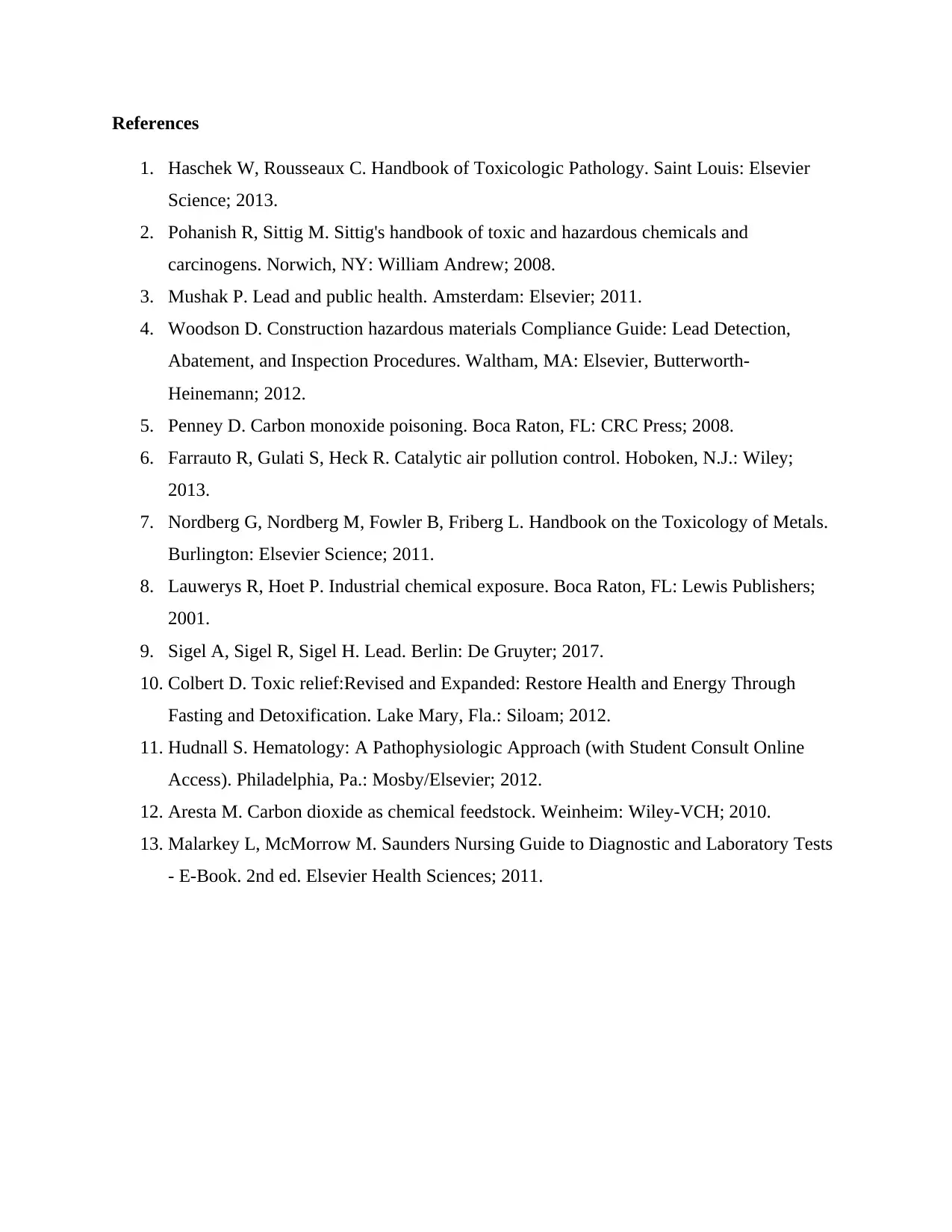
References
1. Haschek W, Rousseaux C. Handbook of Toxicologic Pathology. Saint Louis: Elsevier
Science; 2013.
2. Pohanish R, Sittig M. Sittig's handbook of toxic and hazardous chemicals and
carcinogens. Norwich, NY: William Andrew; 2008.
3. Mushak P. Lead and public health. Amsterdam: Elsevier; 2011.
4. Woodson D. Construction hazardous materials Compliance Guide: Lead Detection,
Abatement, and Inspection Procedures. Waltham, MA: Elsevier, Butterworth-
Heinemann; 2012.
5. Penney D. Carbon monoxide poisoning. Boca Raton, FL: CRC Press; 2008.
6. Farrauto R, Gulati S, Heck R. Catalytic air pollution control. Hoboken, N.J.: Wiley;
2013.
7. Nordberg G, Nordberg M, Fowler B, Friberg L. Handbook on the Toxicology of Metals.
Burlington: Elsevier Science; 2011.
8. Lauwerys R, Hoet P. Industrial chemical exposure. Boca Raton, FL: Lewis Publishers;
2001.
9. Sigel A, Sigel R, Sigel H. Lead. Berlin: De Gruyter; 2017.
10. Colbert D. Toxic relief:Revised and Expanded: Restore Health and Energy Through
Fasting and Detoxification. Lake Mary, Fla.: Siloam; 2012.
11. Hudnall S. Hematology: A Pathophysiologic Approach (with Student Consult Online
Access). Philadelphia, Pa.: Mosby/Elsevier; 2012.
12. Aresta M. Carbon dioxide as chemical feedstock. Weinheim: Wiley-VCH; 2010.
13. Malarkey L, McMorrow M. Saunders Nursing Guide to Diagnostic and Laboratory Tests
- E-Book. 2nd ed. Elsevier Health Sciences; 2011.
1. Haschek W, Rousseaux C. Handbook of Toxicologic Pathology. Saint Louis: Elsevier
Science; 2013.
2. Pohanish R, Sittig M. Sittig's handbook of toxic and hazardous chemicals and
carcinogens. Norwich, NY: William Andrew; 2008.
3. Mushak P. Lead and public health. Amsterdam: Elsevier; 2011.
4. Woodson D. Construction hazardous materials Compliance Guide: Lead Detection,
Abatement, and Inspection Procedures. Waltham, MA: Elsevier, Butterworth-
Heinemann; 2012.
5. Penney D. Carbon monoxide poisoning. Boca Raton, FL: CRC Press; 2008.
6. Farrauto R, Gulati S, Heck R. Catalytic air pollution control. Hoboken, N.J.: Wiley;
2013.
7. Nordberg G, Nordberg M, Fowler B, Friberg L. Handbook on the Toxicology of Metals.
Burlington: Elsevier Science; 2011.
8. Lauwerys R, Hoet P. Industrial chemical exposure. Boca Raton, FL: Lewis Publishers;
2001.
9. Sigel A, Sigel R, Sigel H. Lead. Berlin: De Gruyter; 2017.
10. Colbert D. Toxic relief:Revised and Expanded: Restore Health and Energy Through
Fasting and Detoxification. Lake Mary, Fla.: Siloam; 2012.
11. Hudnall S. Hematology: A Pathophysiologic Approach (with Student Consult Online
Access). Philadelphia, Pa.: Mosby/Elsevier; 2012.
12. Aresta M. Carbon dioxide as chemical feedstock. Weinheim: Wiley-VCH; 2010.
13. Malarkey L, McMorrow M. Saunders Nursing Guide to Diagnostic and Laboratory Tests
- E-Book. 2nd ed. Elsevier Health Sciences; 2011.
1 out of 10
Related Documents
Your All-in-One AI-Powered Toolkit for Academic Success.
+13062052269
info@desklib.com
Available 24*7 on WhatsApp / Email
![[object Object]](/_next/static/media/star-bottom.7253800d.svg)
Unlock your academic potential
Copyright © 2020–2025 A2Z Services. All Rights Reserved. Developed and managed by ZUCOL.




